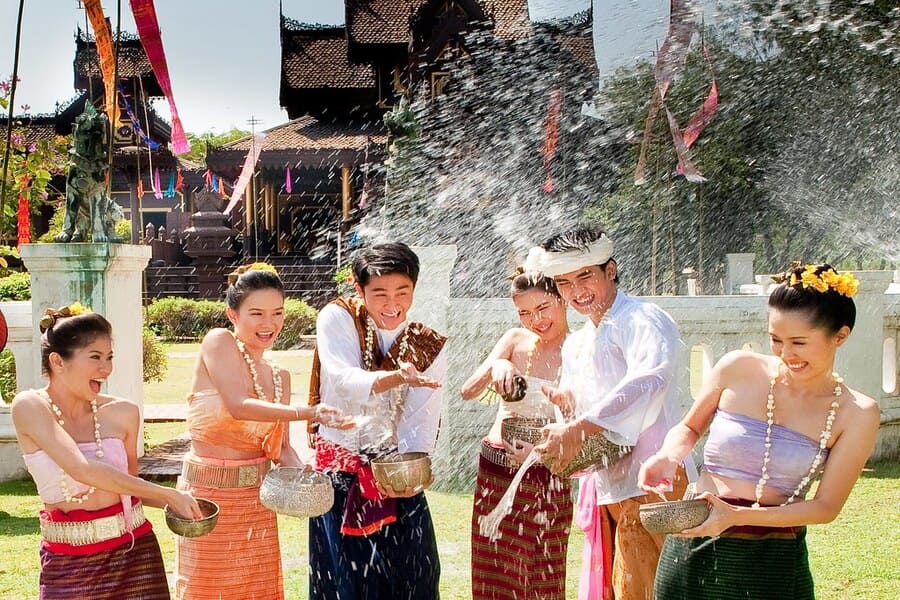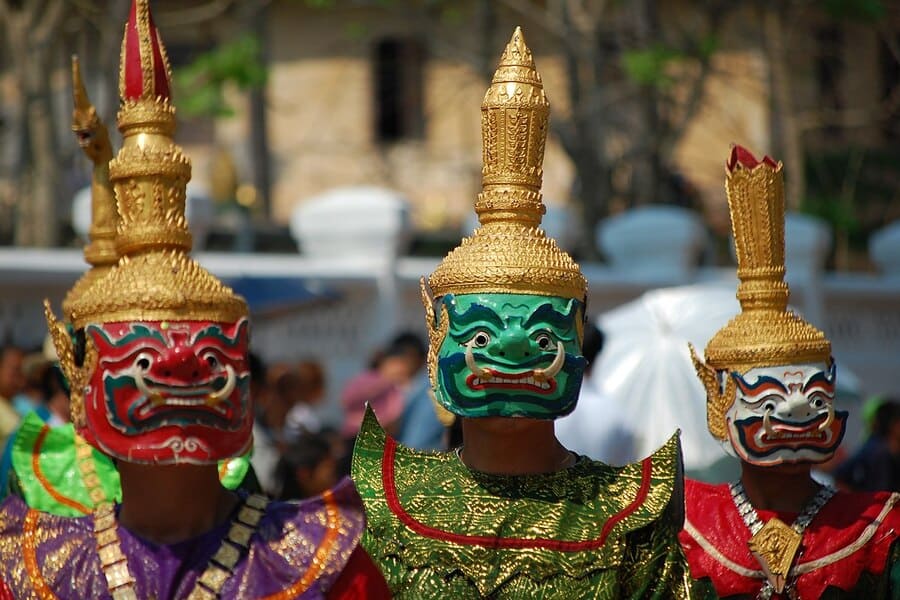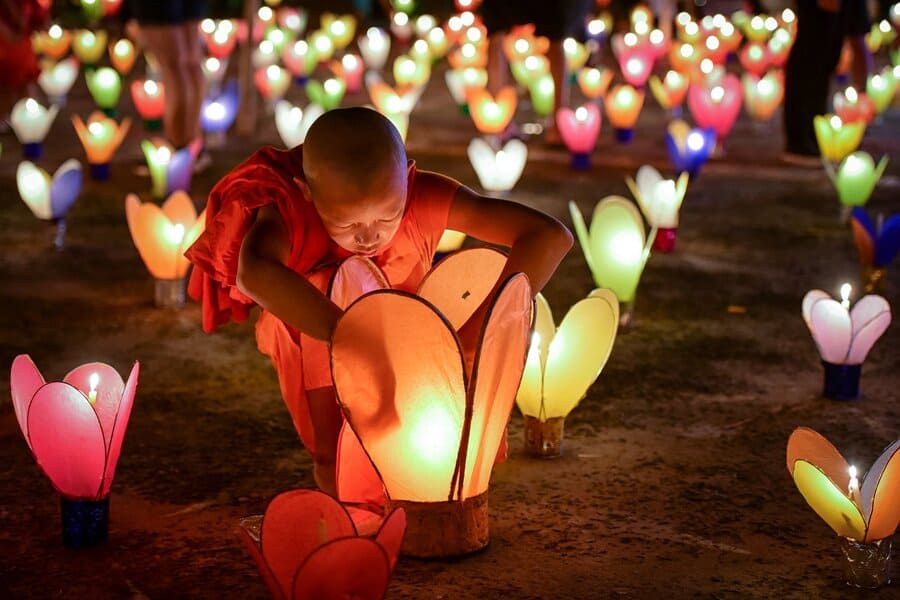Laos celebrates many annual festivals called “Boun” in the Lao Language which are particularly enjoyable and beautiful, signifying traditional aspects of Lao lifestyle. Most Laos festivals are connected with religion and the yearly rice farming cycle.
Boun Khao Chi (Makhaboucha)
Date: 5 February 2023
Boun Khoa Chi is one of the most important Buddhist Laos Festival celebrate on the full moon day of the lunar month in Laos
Meanings:
- Commemorating the Buddha’s Teachings: Boun Khao Chi honors a special sermon delivered by the Buddha where he summarized his core teachings for a large assembly of monks.
- Monastic Retreat: The full moon of the third lunar month traditionally marks the beginning of the vassa, a three-month rainy season retreat for monks. During this time, monks stay within the temple grounds and focus on meditation and teachings.
- Merit-Making: The festival offers an opportunity for lay Buddhists to make merit by offering food, candles, and other necessities to monks preparing for the vassa retreat.
Activities:
- Temple Offerings: Devotees visit temples to make offerings to monks and participate in merit-making activities.
- Candle Procession: In some areas, a candlelit procession might be held, symbolizing the dispelling of darkness and illuminating the path to enlightenment.
- Almsgiving: Almsgiving ceremonies may take place, where lay people offer food to monks.
- Temple Activities: Monasteries might host special chanting sessions, dharma talks, and religious ceremonies.
- Community Gatherings: The festival can also be a time for community gatherings, with food stalls and local vendors setting up near temples.
Boun Phavet
The Boun Khoun Khao, also known as Boun Khoun Lan (both meaning “Rice Ceremony”), is a harvest festival celebrated in Laos
Date: The exact date can vary slightly year to year, but it typically falls around the full moon of the eleventh lunar month according to the Lao lunar calendar
Meanings:
- Gratitude for Harvest: Boun Khoun Khao serves as a time to express gratitude to the spirits and deities for a bountiful rice harvest. Rice is a staple food in Laos, and a successful harvest ensures food security and prosperity for the community.
- Offerings and Merit-Making: Devotees offer rice, food, and other necessities to monks at temples. This act of merit-making brings good karma and blessings for future harvests.
- Ancestral Veneration: The festival can also involve honoring ancestors who have passed down knowledge and skills related to rice cultivation.
Activities:
- Almsgiving Ceremonies: Lay people offer cooked rice, vegetables, and other food to monks, symbolizing sharing the bounty of the harvest.
- Rice Offering Rituals: Special ceremonies at temples might involve offering baskets of rice and chanting prayers of gratitude.
- Community Gatherings: Villagers come together for celebrations, with food stalls, traditional music and dance performances, and games.
- Building Merit: People might participate in merit-making activities like temple renovations, donations to the monks, or releasing captive animals.
Pimai Lao/Lao New Year
Pimai Lao, also known as Lao New Year, is a vibrant and joyful celebration marking the start of the Lao solar calendar. Here’s a breakdown of the key details:
Date: Pimai Lao takes place over three days, typically starting on the 13th, 14th, and 15th days of the waxing moon in the Lao lunar calendar. This usually translates to mid-April.
Meanings:
- New Beginnings: Pimai Lao signifies a fresh start and the cleansing of bad luck from the previous year. It’s a time to focus on renewal, hope, and prosperity for the year ahead.
- Water Blessings: Water plays a significant role in the festival, symbolizing washing away negativity and bad luck. People sprinkle water on each other, with a gentle “Sawasdee Pimai!” (Happy New Year in Lao).
- Merit-Making: Making merit through offerings to monks and acts of generosity is a core aspect of the festival.
- Ancestral Veneration: People pay respects to their ancestors and deceased family members.
Activities:
- Water Throwing: The most recognizable feature is the playful water throwing, using buckets, water guns, or simply splashing with cupped hands. It’s a joyous social interaction and a way to cleanse oneself for the new year.
- Temple Ceremonies: Devotees visit temples to make offerings, participate in merit-making activities, and receive blessings from monks.
- Family Gatherings: Families come together for reunions, share meals, and celebrate the new year.
- Boun Bang Fai (Rocket Festival): In some areas, particularly in the northeast, the Rocket Festival (Boun Bang Fai) might coincide with Pimai Lao celebrations. This involves launching home-built rockets, believed to propitiate the heavens for good rain.
- Parades and Performances: Colorful parades with dancers in traditional costumes, musicians, and floats might add to the festive atmosphere. Traditional music and dance performances can be enjoyed.
- Games and Activities: Traditional Laotian games, food stalls with delectable Lao cuisine, and other festive activities might be part of the celebrations.
Asalahaboucha Day and Boun Khao Phansa Festival (Buddhist Lent)
Asalha Puja Day
Date: Falls on the full moon of the eighth lunar month according to the Lao lunar calendar. This typically translates to July.
Meanings:
- Commemorating the Buddha’s Teachings: Asalha Puja honors the Buddha’s first sermon delivered to his five disciples, marking the founding of the Buddhist Sangha (monastic community).
- Start of Buddhist Lent: It signifies the beginning of Phansa, a three-month period of heightened spiritual focus and discipline for Theravada Buddhist monks and followers.
Activities:
- Temple Offerings: Devotees visit temples to make offerings to monks and participate in merit-making activities.
- Candlelit Processions: In some areas, there might be candlelit processions symbolizing the dispelling of darkness and illuminating the path to enlightenment.
- Dharma Talks: Monks might deliver special sermons reflecting on the Buddha’s teachings and the significance of Phansa.
- Lay Observances: Some lay Buddhists might undertake additional observances during Phansa, such as abstaining from alcohol or certain types of entertainment.
Boun Khao Phansa Festival
Date: Coincides with Asalha Puja Day.
Meanings:
- Merit-Making for Monks: The festival offers an opportunity for lay Buddhists to make merit by providing requisites like robes, food, and other necessities to monks who will remain in monasteries during Phansa.
- Community Gatherings: Celebrates the beginning of Phansa and fosters a sense of community spirit.
Activities:
- Almsgiving Ceremonies: Lay people offer food to monks, symbolizing support for their monastic retreat.
- Rice Offering Rituals: Special ceremonies at temples might involve offering baskets of rice and chanting prayers for a successful Phansa retreat.
- Community Festivities: There might be food stalls, traditional music and dance performances, and local games.
- Temple Activities: Monasteries might host special chanting sessions, dharma talks, and religious ceremonies.
Laos National Day
Lao National Day, also known as That Luang Festival, is a major national holiday in Laos. Here’s a breakdown of the key details:
Date: Celebrated annually on December 2nd.
Meanings:
- Commemorating Independence: Lao National Day marks the anniversary of Laos’s independence from French colonial rule in 1953.
- National Unity and Pride: It’s a day to celebrate Laotian culture, heritage, and national identity. People come together to express their pride in their country.
- Respecting Traditions: The festival incorporates Buddhist traditions and rituals, reflecting the deep importance of Buddhism in Laotian culture.
Activities:
- Official Ceremonies: Government officials might lay wreaths at the That Luang stupa and participate in official speeches and ceremonies.
- Religious Observances: Buddhist monks might perform special merit-making ceremonies and blessings at temples throughout the country.
- Boun That Luang Festival: The celebrations coincide with the Boun That Luang Festival, a vibrant folk festival centered around the That Luang stupa.
- Parades and Processions: Colorful parades with floats depicting Laotian history and culture, traditional dancers in elaborate costumes, and marching bands fill the streets.
- Food and Entertainment: Fairs and markets offering delicious Laotian cuisine, local handicrafts, and traditional performances add to the festive atmosphere.
- Lighting Ceremonies: The That Luang stupa is beautifully illuminated at night, creating a magical spectacle.
Exploring Laos through its unique festivals offers a captivating glimpse into the country’s rich cultural tapestry and spiritual traditions.
By immersing yourself in these celebrations during your Laos tour, you’ll not only witness the beauty of local customs but also forge connections with the welcoming people of Laos. Embrace the opportunity to unveil the essence of Laos through its festivals and create cherished memories that will last a lifetime.



